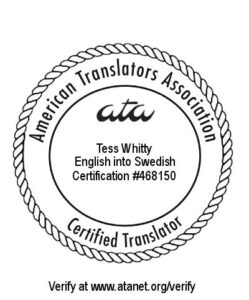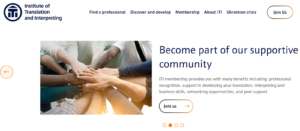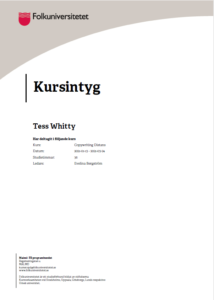My Professional English to Swedish Translator Certifications

As an English-Swedish linguist with 20 years of experience, I’m committed to growing in my profession.
To that end, I’m always looking for opportunities to get certified in key areas and add value for my clients. While translator certifications vary in scope depending on the institution, they’re a great way for you to understand the depth and breadth of my skills.
Here I’ll go through some of my top translator certifications, so you can get a better sense of my professional English to Swedish expertise.
My English to Swedish Translator Certifications
A certified translator must pass a professional exam to demonstrate their language skills. While these certification tests vary by country and vertical, I’ve demonstrated professional competence in leading institutions in the U.S., U.K. and Sweden – see below!
1. ATA Certification for English to Swedish

Certification since: 2015
About the certification: I’ve been certified by ATA since 2015 in English to Swedish. The ATA (American Translators Association) certification demonstrates the highest standards of the translation profession in the U.S., including competence in a specific language combination and commitment to the profession and its ethical practice.
2. MITI Qualified Member Certification

Certification since: 2014
About the certification: In addition, I’m certified in English to Swedish by the U.K.’s premiere organization, the Institute of Translators and Interpreters (ITI). ITI provides qualified member certification to translators with a minimum of three years in their relevant field who pass a high-level assessment.
3. SEMRush Certification in Content Marketing and iSEO

Certification since: 2021
About the certification: In an effort to elevate my services with relevant digital marketing expertise, I’ve also completed two SEMRush courses in content marketing and iSEO. I’m now able to provide value-added services, including defining iSEO, localizing PPC-ads and translating a range of digital marketing materials into Swedish.
4. Swedish Copywriting Certification

Certification since: 2021
About the certification: Finally, great writing is at the core of any Swedish translations. To enhance my creative translation skills, I participated in a six-week copywriting course in Swedish and became certified in key concepts such as perfecting rhetoric and wordsmithing according to the type of material.
Hire Me for Your Next English-Swedish Project
Through my extensive experience and courses, I’ve become well-versed in industry-best translation practices, high-quality Swedish writing and SEO research. No matter your Swedish localization needs, I’m ready to get top outcomes for your business.
Check out successful case studies of projects I’ve done for recent clients and reach out to Swedish Translation Services to start discussing your needs!
Check Also:


